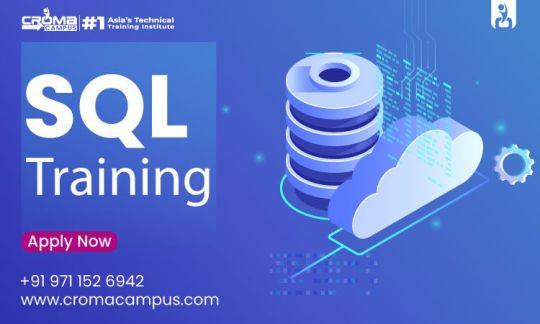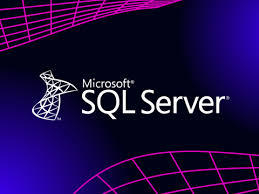#SQL Online Training
Explore tagged Tumblr posts
Text

Discover the power of SQL through SQL Online Training, an educational program that provides individuals with an online platform for learning the language. A wide range of SQL topics and techniques are covered in this training program, such as syntax, database design, querying techniques, data manipulation, and optimization strategies. Participants will gain hands-on experience with SQL databases.
#SQL Online Training#SQL Server Online Course#SQL Server Online Certification#certification#education#training#cromacampus
0 notes
Text

SQL Interview Questions
The following SQL interview questions and answers are designed to familiarize candidates with common interview questions.
#besttraininginstitute#traininginstitute#onlinetraining#training#online#coding#tutorial#technology#trending#design#infographics#sql#mysql#database#programming#engineering
5 notes
·
View notes
Text

power bi course syllabus | power bi certification syllabus Boost your career with our Power BI Certification Course online. Join now for expert training and take the next step in IT success.
power bi online training india ,power bi online instructor led training ,power bi course syllabus | power bi certification syllabus ,power bi course curriculum | dax certification ,power bi certification course | dax certification course ,
#power bi online training india#power bi online instructor led training#power bi course syllabus | power bi certification syllabus#power bi course curriculum | dax certification#power bi certification course | dax certification course#sql#power bi#power bi certification cost#power bi course#msbi#data analytics#education#power bi certification#power bi online training#power bi course fees
3 notes
·
View notes
Text
In today’s data-driven world, Structured Query Language (SQL) has become an essential skill for professionals working in database management, data analysis, and software development. As businesses rely heavily on data storage, retrieval, and security, the demand for skilled SQL professionals is on the rise. Enrolling in an SQL course in Hyderabad can provide aspiring professionals with the necessary expertise to manage and manipulate databases effi ciently.
#medical coding certification online#medical coding#medical coding training#best sql dba training#best sql course in hyderabad
0 notes
Text
🚀 Take Your IT Skills to the Next Level! Join our Classroom & Online Training starting from 17th Feb 2025 with guidance from top-notch faculty! 💻 FREE Demo Class – Experience the learning environment firsthand! 📲 Register Today: linktr.ee/nareshit.kphb
📚 Courses Offered: ✅ Data Analytics & Business Analytics – By Mr. Rahul ✅ Full Stack Java – By Mr. Shivam Kumar ✅ Oracle – By Mr. Shiva Chaitanya ✅ Full Stack Python – By Ms. Kavitha ✅ HTML | CSS | JavaScript – By Mr. Manoj
👩💻 Let’s build your future together!

#it training#datascience#data analytics#html#python#java#sql#powerbi#coding#programming#online education#azure#js#dotnet#c
1 note
·
View note
Text
Mastering Data Wrangling in SAS: Best Practices and Techniques
Data wrangling, also known as data cleaning or data preparation, is a crucial part of the data analysis process. It involves transforming raw data into a format that's structured and ready for analysis. While building models and drawing insights are important tasks, the quality of the analysis often depends on how well the data has been prepared beforehand.
For anyone working with SAS, having a good grasp of the tools available for data wrangling is essential. Whether you're working with missing values, changing variable formats, or restructuring datasets, SAS offers a variety of techniques that can make data wrangling more efficient and error-free. In this article, we’ll cover the key practices and techniques for mastering data wrangling in SAS.
1. What Is Data Wrangling in SAS?
Before we dive into the techniques, it’s important to understand the role of data wrangling. Essentially, data wrangling is the process of cleaning, restructuring, and enriching raw data to prepare it for analysis. Datasets are often messy, incomplete, or inconsistent, so the task of wrangling them into a clean, usable format is essential for accurate analysis.
In SAS, you’ll use several tools for data wrangling. DATA steps, PROC SQL, and various procedures like PROC SORT and PROC TRANSPOSE are some of the most important tools for cleaning and structuring data effectively.
2. Key SAS Procedures for Data Wrangling
SAS offers several powerful tools to manipulate and clean data. Here are some of the most commonly used procedures:
- PROC SORT: Sorting is usually one of the first steps in data wrangling. This procedure organizes your dataset based on one or more variables. Sorting is especially useful when preparing to merge datasets or remove duplicates.
- PROC TRANSPOSE: This procedure reshapes your data by converting rows into columns or vice versa. It's particularly helpful when you have data in a "wide" format that you need to convert into a "long" format or vice versa.
- PROC SQL: PROC SQL enables you to write SQL queries directly within SAS, making it easier to filter, join, and aggregate data. It’s a great tool for working with large datasets and performing complex data wrangling tasks.
- DATA Step: The DATA step is the heart of SAS programming. It’s a versatile tool that allows you to perform a wide range of data wrangling operations, such as creating new variables, filtering data, merging datasets, and applying advanced transformations.
3. Handling Missing Data
Dealing with missing data is one of the most important aspects of data wrangling. Missing values can skew your analysis or lead to inaccurate results, so it’s crucial to address them before proceeding with deeper analysis.
There are several ways to manage missing data:
- Identifying Missing Values: In SAS, missing values can be detected using functions such as NMISS() for numeric data and CMISS() for character data. Identifying missing data early helps you decide how to handle it appropriately.
- Replacing Missing Values: In some cases, missing values can be replaced with estimates, such as the mean or median. This approach helps preserve the size of the dataset, but it should be used cautiously to avoid introducing bias.
- Deleting Missing Data: If missing data is not significant or only affects a small portion of the dataset, you might choose to remove rows containing missing values. This method is simple, but it can lead to data loss if not handled carefully.
4. Transforming Data for Better Analysis
Data transformation is another essential part of the wrangling process. It involves converting or modifying variables so they are better suited for analysis. Here are some common transformation techniques:
- Recoding Variables: Sometimes, you might want to recode variables into more meaningful categories. For instance, you could group continuous data into categories like low, medium, or high, depending on the values.
- Standardization or Normalization: When preparing data for machine learning or certain statistical analyses, it might be necessary to standardize or normalize variables. Standardizing ensures that all variables are on a similar scale, preventing those with larger ranges from disproportionately affecting the analysis.
- Handling Outliers: Outliers are extreme values that can skew analysis results. Identifying and addressing outliers is crucial. Depending on the nature of the outliers, you might choose to remove or transform them to reduce their impact.
5. Automating Tasks with SAS Macros
When working with large datasets or repetitive tasks, SAS macros can help automate the wrangling process. By using macros, you can write reusable code that performs the same transformations or checks on multiple datasets. Macros save time, reduce errors, and improve the consistency of your data wrangling.
For example, if you need to apply the same set of cleaning steps to multiple datasets, you can create a macro to perform those actions automatically, ensuring efficiency and uniformity across your work.
6. Working Efficiently with Large Datasets
As the size of datasets increases, the process of wrangling data can become slower and more resource-intensive. SAS provides several techniques to handle large datasets more efficiently:
- Indexing: One way to speed up data manipulation in large datasets is by creating indexes on frequently used variables. Indexes allow SAS to quickly locate and access specific records, which improves performance when working with large datasets.
- Optimizing Data Steps: Minimizing the number of iterations in your DATA steps is also crucial for efficiency. For example, combining multiple operations into a single DATA step reduces unnecessary reads and writes to disk.
7. Best Practices and Pitfalls to Avoid
When wrangling data, it’s easy to make mistakes that can derail the process. Here are some best practices and common pitfalls to watch out for:
- Check Data Types: Make sure your variables are the correct data type (numeric or character) before performing transformations. Inconsistent data types can lead to errors or inaccurate results.
- Be Cautious with Deleting Data: When removing missing values or outliers, always double-check that the data you're removing won’t significantly affect your analysis. It's important to understand the context of the missing data before deciding to delete it.
- Regularly Review Intermediate Results: Debugging is a key part of the wrangling process. As you apply transformations or filter data, regularly review your results to make sure everything is working as expected. This step can help catch errors early on and save time in the long run.
Conclusion
Mastering data wrangling in SAS is an essential skill for any data analyst or scientist. By taking advantage of SAS’s powerful tools like PROC SORT, PROC TRANSPOSE, PROC SQL, and the DATA step, you can clean, transform, and reshape your data to ensure it's ready for analysis.
Following best practices for managing missing data, transforming variables, and optimizing for large datasets will make the wrangling process more efficient and lead to more accurate results. For those who are new to SAS or want to improve their data wrangling skills, enrolling in a SAS programming tutorial or taking a SAS programming full course can help you gain the knowledge and confidence to excel in this area. With the right approach, SAS can help you prepare high-quality, well-structured data for any analysis.
#sas programming tutorial#sas programming#sas online training#data wrangling#proc sql#proc transpose#proc sort
0 notes
Text
Understanding SQL Server

Introduction
SQL Server is a relational database management system (RDBMS) developed by Microsoft. It is designed to store and manage large volumes of data efficiently while ensuring high performance, scalability, and security. This article delves into the key features, architecture, and benefits of SQL Server, along with best practices for database management.
Key Features of SQL Server
1. Relational Database Management
At its core, SQL Server uses a relational database model, allowing data to be organized in tables that can be easily accessed and managed. Tables are structured into rows and columns, making it straightforward to retrieve and manipulate data using SQL (Structured Query Language).
2. Scalability and Performance
SQL Server is built to handle varying loads, from small applications to large enterprise-level systems. Its architecture supports horizontal and vertical scaling, allowing businesses to expand their database as their data needs grow. Features like partitioning, indexing, and in-memory processing enhance performance, making SQL Server suitable for high-transaction environments.
3. Security Features
Security is paramount in database management, and SQL Server offers robust security mechanisms. Role-based security, encryption (both at rest and in transit), and advanced auditing features help safeguard sensitive data against unauthorized access and breaches.
4. High Availability and Disaster Recovery
SQL Server provides several options for high availability and disaster recovery. Techniques such as Always On Availability Groups, database mirroring, and backup/restore strategies ensure that data remains accessible even in the event of hardware failures or disasters.
5. Integration Services (SSIS)
SQL Server Integration Services (SSIS) is a powerful data integration tool that allows users to extract, transform, and load (ETL) data from various sources. This capability is crucial for data warehousing and business intelligence applications, enabling organizations to consolidate data from different platforms.
6. Reporting Services (SSRS)
SQL Server Reporting Services (SSRS) provides comprehensive tools for generating, managing, and delivering reports. Users can create interactive reports, dashboards, and visualizations, allowing decision-makers to derive insights from data effectively.
7. Analysis Services (SSAS)
SQL Server Analysis Services (SSAS) offers analytical capabilities, allowing users to perform multidimensional analysis and data mining. It supports the creation of OLAP cubes and complex analytical models, which facilitate advanced data analysis and reporting.
SQL Server Architecture
Understanding SQL Server architecture is essential for database administrators and developers. The architecture can be broadly divided into several components:
1. Database Engine
The database engine is the core component of SQL Server, responsible for managing data storage, retrieval, and processing. It includes the query processor, storage engine, and transaction log management.
2. SQL Server Instance
An instance is a separate installation of SQL Server. Multiple instances can run on a single server, allowing for isolation and management of different applications or environments.
3. Databases
Each instance can contain multiple databases. A database is a collection of related data, organized in a structured format. SQL Server supports multiple database types, including user-defined and system databases.
4. Data Files and Log Files
SQL Server uses data files (.mdf and .ndf) to store data and log files (.ldf) to maintain transaction logs. Data files hold the actual data, while log files track all transactions, ensuring data integrity and facilitating recovery.
Benefits of SQL Server
1. Ease of Use
SQL Server's user-friendly interface and comprehensive documentation make it accessible to both novice and experienced database administrators. Tools like SQL Server Management Studio (SSMS) provide intuitive graphical interfaces for managing databases.
2. Strong Community Support
As a widely used database management system, SQL Server has a robust community of users and developers. This community contributes to a wealth of online resources, forums, and third-party tools, providing support for troubleshooting and optimization.
3. Integration with Other Microsoft Products
SQL Server seamlessly integrates with other Microsoft products, such as Excel, Power BI, and Azure. This integration enhances data analysis and visualization capabilities, allowing organizations to leverage their data effectively.
4. Comprehensive Development Tools
SQL Server offers a variety of development tools, including Visual Studio integration, T-SQL for writing queries, and APIs for connecting applications. These tools facilitate efficient database development and management.
Best Practices for SQL Server Management
To ensure optimal performance and security, consider the following best practices:
1. Regular Backups
Implement a robust backup strategy, including full, differential, and transaction log backups. Regular backups help protect against data loss and ensure quick recovery in case of failures.
2. Performance Monitoring
Utilize SQL Server’s built-in monitoring tools to track performance metrics, identify bottlenecks, and optimize queries. Tools like SQL Server Profiler and Performance Monitor can provide insights into query performance and system health.
3. Security Management
Regularly review and update security settings, including user permissions and roles. Implement encryption for sensitive data and use auditing features to monitor access and changes.
4. Indexing Strategy
Develop a sound indexing strategy to enhance query performance. Regularly review and optimize indexes to ensure efficient data retrieval without unnecessary overhead.
5. Documentation and Change Management
Maintain thorough documentation of database structures, configurations, and changes. This practice aids in troubleshooting, compliance, and knowledge sharing among team members.
0 notes
Text

🚀 Become a Professional in SQL - The Most In-Demand Skill of 2024! 🚀
💼 Gain mastery over:
Database Management Data Warehouse T-SQL Queries Data Validation Nested Queries 🗓️ 45 Days of Live Online Classes 💻 Work on Real-World Projects 📜 50+ Hours of Learning with Certification 🎯 Dedicated Career Coach & Personal Mentor
📉 80% OFF – Enroll now for just ₹499 (original ₹25,000)! 🔗 Limited Offer: https://www.learn24x.com/contactus
📞 For more info: +91 80962 66265 📧 [email protected]
🎯 Don't miss this incredible opportunity to upskill and boost your career prospects!
#SQLTraining #DataSkills #LearnSQL #CareerGrowth #OnlineLearning #DigitalSkills.
#online courses#sql training#data skills#learnsql#edutech#education#career guidance#learn24x#coding#online teaching#career growth#coding skills#ai
0 notes
Text

Best SQL Courses : Great Learning Courses
#data science training in gurgaon#best sql courses#sql course#sql courses near me#sql online course#sql course in gurgaon#data science course in gurgaon
0 notes
Text

Croma Campus specialises in IT and professional training and is recognized as a leading education provider. We offer SQL Server Online Course by certified trainers and expert guidance to help students achieve their career goals.
0 notes
Text
A Microsoft SQL Certification is a must-have for any individual who endeavors to thrive in the field of information technology. It often offers you the privilege to have wider career options, receive better pay, and boost your trustworthiness. If you are a person who believes that the IT field is the best place to build your career, get the first step by being certified in MS SQL Server.
#Microsoft SQL Certification#SQL Certification#SQL Certificate#SQL Training Courses#SQL Certification Online#SQL Server Certification#SQL Certification Course#SQL Server Training#Microsoft SQL Server Certification#Microsoft SQL Training#SQL Training and Certification#Microsoft SQL Server Training#SQL Server Online Training#sql certifications#ms sql certification
0 notes
Text
power bi course curriculum | dax certification Boost your career with our Power BI Certification Course online. Join now for expert training and take the next step in IT success.
power bi online training india , power bi online instructor led training , power bi course syllabus | power bi certification syllabus , power bi course curriculum | dax certification , power bi certification course | dax certification course
#power bi online training india#power bi online instructor led training#power bi course syllabus | power bi certification syllabus#power bi course curriculum | dax certification#power bi certification course | dax certification course#data analytics#education#power bi#power bi certification#sql#power bi certification cost#msbi#power bi course fees#power bi online training#power bi course
2 notes
·
View notes
Text
Data Analysis Online: Crafting a Learning Path for Success

In today's data-driven world, mastering data analysis is essential for professionals across various industries. As the demand for data analysis skills continues to grow, individuals are turning to online learning platforms to acquire the knowledge and expertise needed to succeed in this field. Crafting a structured learning path is key to achieving success in data analysis online. Let's explore how to design a learning path tailored to mastering data analysis and advancing your career aspirations.
1. Assess Your Current Skill Level:
Before diving into data analysis online, it's essential to assess your current skill level and identify areas for improvement. Evaluate your proficiency in essential tools and concepts such as Python programming, SQL querying, and basic statistical analysis. Understanding your strengths and weaknesses will help you tailor your learning path to address specific skill gaps and build a solid foundation for success.
2. Identify Learning Objectives:
Define clear learning objectives to guide your data analysis journey. Whether you're aiming to become proficient in Python programming for data analysis, master SQL for database querying, or explore advanced topics like machine learning and big data analytics, setting specific goals will help you stay focused and motivated throughout your learning experience.
3. Choose High-Quality Courses:
Selecting the right courses is crucial for mastering data analysis online. Look for reputable online platforms that offer a wide range of courses covering various aspects of data analysis, including Python programming, SQL querying, and specialized topics like Apache Spark for big data analytics. Consider factors such as course content, instructor expertise, hands-on learning opportunities, and student reviews when choosing the best data analysis courses online.
4. Build a Solid Foundation:
Begin your learning journey by focusing on building a solid foundation in essential data analysis skills. Start with introductory courses that cover fundamental concepts and techniques, such as Python programming basics, SQL querying fundamentals, and data manipulation and visualization. These foundational skills will serve as the building blocks for more advanced topics and specialized areas of data analysis.
5. Dive Deeper into Specialized Topics:
Once you've established a strong foundation, explore specialized topics and advanced techniques to expand your data analysis skill set. Delve into courses that cover advanced Python programming for data analysis, advanced SQL querying and database management, and specialized tools and libraries for tasks like data visualization, machine learning, and big data processing with Apache Spark. By exploring specialized topics, you can deepen your expertise and unlock new opportunities in data analysis.
6. Practice, Practice, Practice:
Practice is essential for mastering data analysis skills. Apply what you've learned in your courses to real-world projects, datasets, and problem-solving scenarios. Engage in hands-on exercises, projects, and challenges to reinforce your learning, develop practical skills, and build a portfolio of work that showcases your expertise in data analysis.
In conclusion, crafting a learning path for success in data analysis online requires careful planning, dedication, and a commitment to continuous learning. By assessing your current skill level, setting clear learning objectives, choosing high-quality courses, building a solid foundation, exploring specialized topics, practicing regularly, and staying updated with industry trends, you can embark on a rewarding journey to master data analysis and achieve your career goals.
#apache spark course#data analysis#data analysis skill#python course#best python course#data analysis course#data analysis course online#master data analysis#python course online#sql course#sql course online#best sql course#data analysis online#python course training#sql course training#apache spark course online#best apache spark course#scholarnest#scholarnest technologies
1 note
·
View note
Text
Stay Competitive in the Job Market with SQL Server Online Training from in2inglobal.com
Do you need to grow your enterprise and live in advance in these days’s aggressive job market? Look no similarly than SQL Server online education from in2inglobal.Com! Our superior publications and skilled running shoes will give you the competencies and expertise you want to excel in the international of records management. Don’t miss this opportunity to enhance your resume and stick out from capability employers. Join us at in2inglobal.Com for a rewarding gaining knowledge of enjoy in order to set you apart from the opposition!
1. Best MySQL Courses Online: Our pinnacle choose for the excellent on-line MySQL guides is obtainable via in2inglobal.com. This complete route covers everything from basic to advanced topics, permitting you to broaden MySQL abilties right away. With arms-on physical games and real-international obligations, you can practice your talents in a sensible setting.
2. Microsoft SQL Server Certification Courses: To get licensed in Microsoft SQL Server, look no in addition than the certification courses offered by way of Microsoft itself. This course covers all of the important functions of Microsoft SQL Server, such as installation, configuration, and protection. Upon crowning glory of this course, you'll be well prepared to take the Microsoft SQL Server certification exam and exhibit your skills to capability employers.

3. Microsoft SQL Server Training: For an in-depth training experience, keep in mind enrolling in the Microsoft SQL Server education application provided by using in2inglobal.Com. Designed for novices and skilled professionals, this route allows you to learn at your own tempo. With skilled teachers and fingers-on workshops, you will advantage sensible competencies that permit you to enhance your profession in database management.
In end, making an investment in outstanding on line schooling for MySQL and Microsoft SQL Server assist you to live in advance in these days’s aggressive business marketplace. Whether you’re trying to hone your talents or earn a certificate, these guides provide a complete and powerful manner to reap your goals. One of the most important blessings of our on-line schooling application is its flexibility. You can get right of entry to our instructions from anywhere at any time, making it less difficult to get to paintings. So why wait for it? Take your career to the next level with the aid of enrolling in such a top on-line training courses today.
#mysql online training#best mysql course online#Microsoft SQL Server Certification Course#Microsoft SQL Server Training#paid internship
0 notes
Text
Take your career to the next level with our comprehensive Microsoft SQL server certification course. Join in2in global training and get certified today!
#online courses#e learning#online training program#online classes#online tutoring#microsoft sql server#sql#certification course
0 notes
Text
Registration ongoing
0 notes